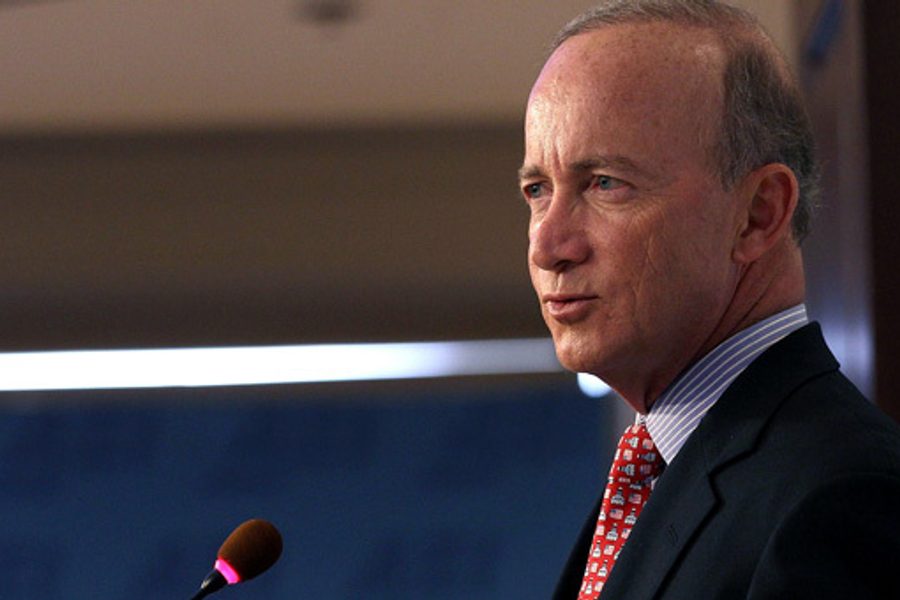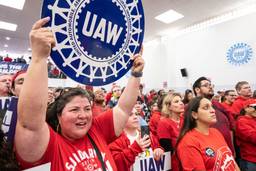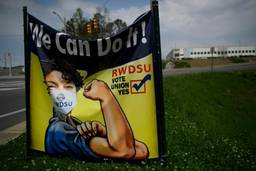
Indiana is now Ground Zero for the national battle between the top 1% and the vast majority in the closely interwoven struggles over the future of democracy, the rights of workers and economic justice in America.
The next week or so may determine whether Indiana Gov. Mitch Daniels and allied Republican legislators, who dominate both houses of the state legislature, succeed in passing the first “right to work” law in a northern industrial state.
A committee of Indiana state lawmakers advanced the controversial “right to work” legislation to the House of Representatives in an 8-5 party line vote Tuesday Morning. House Democrats had ended a three-day long boycott of the bill Monday, but House Democratic Leader Patrick Baur said they may boycott again to stop the bill from advancing, according to Politico. Late Wednesday, a House Democratic spokesman said lawmakers will vote on amendments next Tuesday, the AP reported, after which the bil could advance to the Senate. Republicans, who control the house 60-40, need two-thirds of their members to vote for the measure.
The legislation, which would ban companies and unions from requiring nonunion members to pay for union representation, has been bitterly contested between Republicans and Democrats. Protesters against the bill heckled Indiana Gov. Mitch Daniels’ final “State of the State” address Tuesday night at the Indiana Statehouse, while many of the Democrats’ seats were empty as a form of protest. If “right to work” is approved, Indiana would become the 23rd state to approve the ban, and the first in over a decade.
“Multinational corporations and the Right are pulling out all the stops trying for a win in Indiana with ‘right-to-work’ legislation after they’ve been hit with setbacks in New Hampshire, Wisconsin, and Ohio,” explained Jeff Harris, communications director of the Indiana AFL-CIO.
The anti-labor initiatives launched so boldly a year ago by Republicans elected in the 2010 sweep have splintered after crashing into the rocks of deeply-felt public support for labor rights.
On November 8, the Right was shaken by the overwhelming 61% vote repealing Ohio’s revocation of public-worker union rights. Zealous GOP advocates of “right-to-work” legislation in New Hampshire were unable to overcome a veto by the Democratic governor. In Wisconsin, Gov. Scott Walker and Republican legislators ignited a massive labor uprising as they trampled basic democratic procedures in winning a virtual ban on public-worker union representation.
But Walker and others in Wisconsin are now facing near-certain recall elections, with a set of scandals — most recently, the arrest of Walker appointees in Milwaukee County accused of stealing money from a fund for wounded veterans and engaging in child enticement — further undermining public support.
Now activists on the Right are moving “right-to-work” legislation forward rapidly before public awareness becomes consolidated against it. The heavy financial advantages of the corporate side are drowning out democratic dialogue in Indiana, substituting a blitzkrieg of TV ads for thorough consideration of how right-to-work laws impact a state’s quality of life.
As studies cited by the New York Times Steven Greenhouse indicate, “right-to-work” laws banning the union shop give employers leverage to weaken existing unions by favoring anti-union nonmembers and to disccourage further unionization. Indiana’s current situation would seem to provide all the evidence one needs to demonstrate that the state needs more — not fewer — high-wage, unionized jobs to combat growing poverty:
One in three Hoosiers qualifies as low-income now, compared with one in four a decade earlier. And 58 percent of unemployed Indianans have burned through their benefits…
Workers here have done a backward slip-slide for more than a decade. Median income is falling — by 15 percent in the last decade. The so-called real unemployment rate, which includes those too discouragedto look for work, stood at 17.4 percent last year. And the percentage of Indianans who participate in the work force has dropped in the past two years, much faster than in Illinois and Ohio to the east….
In 2010, wages of workers in unionized manufacturing companies in Indiana were 16 percent higher than in nonunion plants.
Against this backdrop, even the advantages of having a right-wing Republican governor, a 60-40 GOP advantage in the House, and a 37-13 majority in the Senate are not enough to guarantee victory for the right-to-work bill.
Taking advantage of the unlimited corporate spending and removal of public-disclosure requirements enabled by the U.S. Supreme Court’s highly unpopular 2010 Citizens United ruling, the “right-to-work” forces in Indiana are blanketing the state with $600,000 in ads by the shadowy Indiana Opportunity Fund.
The Opportunity Fund is headed up by attorney James Bopp, Jr., who served as one of the lawyers arguing for the removal of constraints on campaign spending for the tycoons gathered in the Citizens United organization. For those seeking to secure the privileged position of the top 1% in Indiana and across America, it is not sufficient for corporations to have a 15-1 spending advantage over labor as they did in the 2008 federal elections.
Daniels, Bopp, and the Opportunity Fund are unwilling to provide the Indiana public with the opportunity to judge their message by considering what their contributors seek to gain. This refusal to reveal donors has triggered widespread calls in numerous newspaper editorials and by civic groups for full disclosure of the list of funders.
Daniels’ legacy
Gov. Daniels’ first act in office in 2005 was to issue an executive order wiping out the collective bargaining rights of public employees, in a move apparently aimed at luring a heavily subsidized Honda plant to a nearly all-white, anti-union region of the state.
That was followed up by the enactment later in 2005 of a highly restrictive voter identification bill that suppresses the votes of unwelcome parts of the electorate, such as African Americans, students, the elderly and the poor, all of whom are likely to lack official photo IDs like a driver’s license or passport. (Indiana was unable to document a single case of voter fraud in persuading the U.S. Supreme Court to uphold the law.)
In 2011, huge throngs of unionists and supporters, estimated at about 75,000, staged rallies inside and outside the Indiana State Capitol against an earlier version of the right-to work bill. At the same time, Democratic members of the House — much like 14 Democratic senators in Wisconsin — took refuge outside the state in order to deny a quorum on the right-to-work bill. Eventually, RTW supporters were forced to back off temporarily.
This time around, the Republicans believe that they have adopted cures for the displays of democratic dissent that disrupted their right-to-work offensive last year. The Republicans won passage of “anti-bolting” penalties of $1,000 per day against legislators who might consider adopting the same tactic of fleeing the state again.
Most recently, the Daniels administration enacted new rules restricting the number of people allowed into the Capitol and even restricted the size of signs. But following a firestorm from across the political spectrum — from the Tea Party to the American Civil Liberties Union, Daniels and his staff backed off at least temporarily from putting the rules into effect, but may still invoke them.
“They had hoped to get the bill passed last week, and were trying to get the most controversial legislation in the last decade passed within two or three days,” AFL-CIO’s Harris said. “But we’ve had 17,000 union members and supporters showing up on the first three days of the new legislative session, and with thousands coming every day,” Harris reported.
“We’ve had phone banks calling our members and the public, and members going door-to-door asking people to call their legislators,” the AFL-CIO official said. “There’s now a good number of Republicans who are saying that they can’t vote for it.”
Appparently, if the bill is passed, Daniels and his allies envision the Feb. 5 Super Bowl as a chance to publicize their success in crushing worker rights — or, alternately, distracting from citizens’ outcry.
But the NFL Players Association has already issued a strong statement denouncing the proposal, and any major delays this month would give Indiana labor an unprecedented worldwide audience for its goal-line stand against the bill.

I hope you found this article important. Before you leave, I want to ask you to consider supporting our work with a donation. In These Times needs readers like you to help sustain our mission. We don’t depend on—or want—corporate advertising or deep-pocketed billionaires to fund our journalism. We’re supported by you, the reader, so we can focus on covering the issues that matter most to the progressive movement without fear or compromise.
Our work isn’t hidden behind a paywall because of people like you who support our journalism. We want to keep it that way. If you value the work we do and the movements we cover, please consider donating to In These Times.







